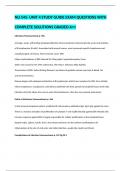Exam (elaborations)
NU 545- UNIT 4 STUDY GUIDE EXAM QUESTIONS WITH COMPLETE SOLUTIONS GRADED A++
- Course
- Institution
NU 545- UNIT 4 STUDY GUIDE EXAM QUESTIONS WITH COMPLETE SOLUTIONS GRADED A++ Infectious Mononucleosis p. 966 A benign, acute, self-limiting lymphoproliferative clinical syndrome characterized by acute viral infection of B lymphocytes (B cells). Associated with several tumors, most commonly specif...
[Show more]



